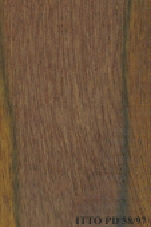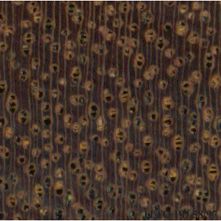
OKAN (Cylicodiscus gabunensis)
Trade Name
Okan
Scientific Name
Cylicodiscus gabunensis Harms
Family
LEGUMINOSAE
Common Names
Denya (Ghana); Bouemon (Côte d`Ivoire); Edoum (Gabon); N'duma (Congo); Uzhi; Usi; Owese; Osung; Olosan; Olisan; Okain; Odenya; Odekowese; Ode owese; Muduma; Mobonran; Mbeli-deli; Lisan; Kendum; Inbeli-deli; Eyee; Emang; Ekam; Edoum; Doum; Djom; Denya; Bouemon; Boueman; Anyan; Aja-igi; Adum; Adada; N`duma (Congo); Oduma (Gabon); Edum (Gabon); African greenheart (Cameroon); Bokoka (Cameroon); Adoum (Cameroon); Okan (Nigeria); Adadua (Ghana); Benya (Ghana)
Scientific Name Synonyms
Piptadenia gabunensis (Harms) Roberty; Erythrophleum le-testui A. Chev.; Erythrophleum gabunense (Harms) Taub.; Cyrtoxiphus staudtii Harms
Description Of The Tree
Botanical Description
The tree reaches a height of more than 50 m. The bole is straight, cylindrical and clear to 26 m in length. The trunk diameter attains from 100 to 130 cm, but it may reach over 300 cm above the buttresses.
Natural Habitat
Cylicodiscus gabunensis occurs in rain forests.
Natural Distribution
West Africa, from Sierra Leone to Gabon.
Wood Identification
Anatomic Description Of Wood
Wood diffuse porous. Occasionally vessels exclusively solitary (over 90%). Tangential diameter of vessel lumina 200 micras or more (large). Brown-colored deposits in heartwood vessels. Vestured pits. Vessels per mm2 less than 6 (rare). Vessel-ray pits similar t Axial parenchyma lozenge-aliform. Axial parenchyma aliform. Prismatic crystals in chambered axial parenchyma cells and/or in fibers. 3 to 4 cells per parenchyma strand. 4 to 10 rays per mm (medium). Rays non-storied. Rays 1 to 4 seriate. Homogeneous rays and/or sub-homogeneous rays (all ray cells procumbent). Non-septate fibers. Fibers with simple to minutely bordered pits.
-
 Wood Macro Photo Tangential Plane
Wood Macro Photo Tangential Plane
-
 Wood Micro Photo Of Transversal Section
Wood Micro Photo Of Transversal Section
Availability
Cites Status
Unrestricted
General Wood Description
Color
The sapwood is greyish pink, it has a thickness of 5 cm. The heartwood is yellow-brown to golden brown, with greenish tinge, it is clearly demarcated. The silver figure is fine.
COLOR INDEX (1=Black, 7=Light yellow,white)
2
Grain
Straight or slightly interlocked, sometimes with an influence on further processing operations.
Texture
The texture is typically medium to coarse.
Luster
Luster is usually low.
Natural Durability
Very durable to decay; without preservative treatment. This species is especially suited for all the uses with risks of permanent or long-lasting humidification. Resistant to termites attack. Heartwood is resistant to Lyctus attacks.
Natural durability index (1= Very high durability, 7=Vey low durability)
1
Internal Growth Stresses
No growth stresses are reported in this species.
Silica Content
Silica Content: This timber is reported to have a negligible silica content. Silica contents over 0.05% may affect wood processing. Silica Value: 0
Resistance To Impregnation
Difficult to treat with only a low penetration of the preservative products.
Wood Physical Properties
Basic Density or Specific Gravity (O.D. weight/vol. green) (g/cm³)
0.80
Air-dry Density (Weight and volume at 12%MC) (g/cm³)
0.91
Total shrinkage Tangential (Saturated to 0%MC) (%)
7.9
Total shrinkage Radial (Saturated to 0%MC) (%)
5.9
Drying Defects
Ease of Drying: Air drying is rated as good.
Recommended Dry Kiln Schedule
FR-12
Dimensional stability ratio (Total Tangential Shrinkage %/Total Radial Shrinkage %)
1.3
Wood Chemical Properties
Wood Mechanical Properties
Bending Strength (MOR),12%MC (kgf/cm²)
1367
Stiffness (MOE) 12%MC (kgf/cm²)
226919
Compression parallel to fiber 12%MC (kgf/cm²)
835
Compression perpendicular to fiber 12%MC (kgf/cm²)
123
Shear strength radial 12%MC (kgf/cm²)
105
Janka hardness (side) 12%MC (kgf)
1047
Janka hardness (end grain) 12%MC (kgf)
1085
Workability
Sawing
Sawing of this species requires powerful equipment.
Rotary Veneer Cutting
Not suitable for veneering.
Sliced Veneer
Not suitable for veneering.
Blunting Effect
Moderate blunting effect; stellited blades for sawing and carbide tools for machining are advised.
Machining
It needs powerful tools for processing. Possible difficulties caused by interlocked grain are reported.
Planing
Rather difficult; special tools are needed.
Moulding
Moderately easy; tools must be cautiously sharpened.
Turning
30
Boring
Moderately easy; tools must be cautiously sharpened.
Mortising
Moderately easy; tools must be cautiously sharpened.
Nailing
Pre-boring is necessary.
Gluing
Difficult to glue because of high density.
Sanding
Easy to perform; it gives good results.
Polishing
Needs pre-coating.
Response To Hand Tools
Working with hand tools is difficult.
REFERENCED USES
End Uses Summary
HOUSING GENERAL, beams, joists, boards, flooring, parquet, frames, FURNITURE AND CABINETS, luxury furniture, cabinets, TURNING, ornaments, turned furniture, cutlery, lasts, CONTAINERS, truck bodies, truck flooring, OTHER AND MUSICAL INSTRUMENTS, handicrafts
General Housing
- 10 - Silica in Timbers
Beams
- 11 - Prospect: The wood database
Joists
- 12 - Tropical timbers of the world. Part I-Tropical American Species
Boards
- 13 - Dry kiln schedules for commercial woods. Temperate and tropical. Section III. Latin American (Mexico, Central, and South America) Woods–Conventional Temperatures
Flooring
- 14 - Handbook of Hardwoods
Parquet
- 15 - Empire Timbers
Frames
- 16 - Woods of the World
Furniture Cabinets
- 21 - Tropical timbers of the world. Part III-Southeast Asian and Oceanian Species.
Furniture, Luxury
- 22 - Dry kiln schedules for commercial woods. Temperate and tropical. Section IV-Asian and Oceanian Woods
Cabinet
- 24 - Empire Timbers
Turning
- 30 - Embassy of Honduras in Japan
Ornaments
- 31 - Embassy of Colombia in Japan
Turned Articles
- 32 - Embassy of Cote d`Ivoire in Japan
Knife Handles
- 33 - Embassy of Gabon in Japan
Lasts
- 34 - Embassy of Indonesia in Japan
Truck Body
- 53 - Timbers of the New World
Truck Flooring
- 54 - Bulletin of the Government Forest Experiment Station N.157: Identification of Tropical Woods
Handcraft
- 66 - Maderas latinoamericanas. VII. Caracteristicas anatomicas. propiedades fisicomecanicas, de secado, y tratabilidad de la madera juvenil de Cordia alliodora (Ruiz & Pav. Oken.)
Please Provide Information To View Producer Information